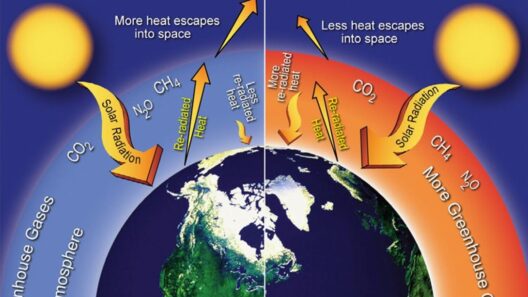Understanding climate and its varied manifestations is critical in the wake of ongoing environmental challenges. Climate is the long-term average of weather patterns in a particular area, encompassing various phenomena such as temperature, humidity, precipitation, and wind patterns. This discourse elucidates examples of climate through real-world weather patterns globally, showcasing how these patterns influence ecosystems, human activities, and the overarching climate system.
At the outset, it is paramount to define the contrast between weather and climate. Weather refers to the immediate atmospheric conditions at a certain place and time, while climate is the broader pattern observed over an extended period, typically 30 years or more. Recognizing this distinction is vital when analyzing specific examples of climate. Weather can shift dramatically from day to day with varying temperatures, winds, and precipitation. In contrast, climate provides a stable framework for understanding these variations.
One of the quintessential examples of climate is the Mediterranean climate. This climatic classification is characterized by hot, dry summers and mild, rainy winters. Regions with a Mediterranean climate, such as California, parts of Australia, and the Mediterranean Basin, experience significant seasonal contrasts. The dry summer months lead to water scarcity issues and necessitate the adaptation of both flora and fauna to survive extreme conditions. The vegetation in these areas includes drought-resistant shrubs and trees, such as cork oaks and olive trees, demonstrating the intricate relationship between climate and biodiversity.
In stark contrast to the Mediterranean climate, the polar climate presents an entirely different reality. Characterized by extremely cold temperatures year-round and minimal precipitation, polar regions like Antarctica and the Arctic are stark landscapes where life struggles to adapt. Here, permafrost dominates the environment, and the ecosystem comprises specialized species, like polar bears and seal populations, intricately linked to this frigid climate. The stark simplicity yet profound complexity of the polar climate illustrates the resilience of life even amid severe conditions.
The humid subtropical climate is another notable example that manifests primarily in the southeastern United States, parts of Asia, and South America. This climate is distinguished by hot, humid summers and mild winters. Precipitation in this region is typically abundant, contributing to lush vegetation and biodiversity. The unique interplay of warm air masses leads to frequent thunderstorms and the possibility of severe weather phenomena, such as hurricanes. The impacts of climate change are particularly evident in humid subtropical regions, where rising sea levels and increased storm intensity pose tremendous risks to coastal communities, prompting discussions about sustainability and resilience.
Furthermore, the tropical rain forest climate embodies a magnificent display of biodiversity seldom matched in any other climate zone. Characterized by consistently high temperatures and significant precipitation year-round, areas such as the Amazon Basin and the Congo River Basin represent the epitome of ecological diversity. The dense canopies of tropical rainforests help regulate climate patterns globally by absorbing carbon dioxide, highlighting a crucial connection between climate, ecosystems, and climate change. As deforestation and climate change threaten these vital habitats, understanding the crucial role of tropical climates in the global climate system is imperative for environmental activism.
Investigating the consequences of climate on human civilization is equally essential. The arid climate found in desert regions, such as the Sahara or the Mojave, exemplifies human adaptation to extreme conditions. These areas receive less than 250 millimeters of precipitation annually and exhibit significant temperature fluctuations between day and night. The sparse vegetation typical of desert climates has led to the development of specialized agricultural practices, including irrigation and advanced water conservation strategies. The survival of communities in arid climates hinges on innovation, underscoring humanity’s resilience and ingenuity in the face of adversity.
The oceanic climate, found in regions such as the Pacific Northwest of the United States and parts of Western Europe, differs prominently from the aforementioned climates. This climate type is characterized by mild temperatures and abundant precipitation throughout the year, allowing lush, green landscapes to flourish. The climate’s stability fosters diverse ecosystems, supporting a rich tapestry of plant and animal life. However, the oceanic climate is not immune to the far-reaching consequences of climate change. Rising sea levels and altered precipitation patterns threaten the very fabric of these ecosystems and the livelihoods of people who depend on these environmental conditions.
Moreover, it is imperative to discuss how climate variability and extreme weather events, such as El Niño and La Niña, profoundly affect global climate patterns. These phenomena exemplify the interconnectedness of atmospheric conditions, ocean currents, and geographical factors, resulting in significant alterations in weather systems worldwide. Such climatic oscillations can lead to droughts in some regions while causing excessive rainfall and flooding in others, emphasizing climate’s dynamic nature and the necessity of comprehensive climate models for predicting future impacts.
In summary, the exploration of climate through various examples, such as the Mediterranean, polar, humid subtropical, tropical rainforest, arid, and oceanic climates, reveals a richly woven tapestry of interactions between environmental conditions and life. Understanding these climatic variations equips societies with the necessary knowledge to adapt and respond to climate challenges, reinforcing the importance of environmental stewardship. Awareness and action are imperative as global temperatures rise and weather patterns become increasingly erratic. The future of humanity and the planet hangs in the balance, necessitating a unified effort to safeguard the delicate equilibrium of our climate and ecosystems.








